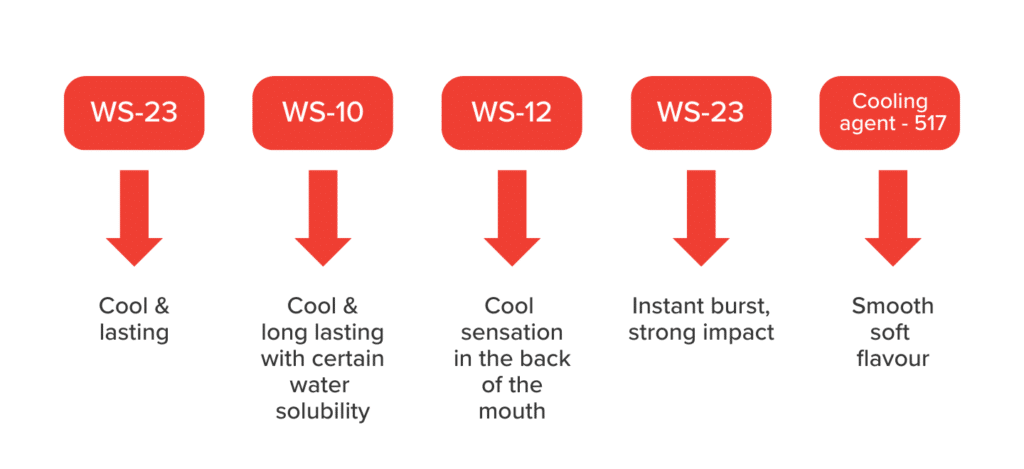Peppermint oil, extracted from the peppermint plant (Mentha × Piperita), has been cherished for its refreshing fragrance and diverse applications across various industries. From ancient remedies to their role in delightful cuisines, let’s delve into the history, uses, and multiple sectors that have embraced the essence of peppermint oil.
Peppermint, a hybrid mint, is believed to have originated from blending watermint and spearmint. Its use dates back to ancient civilisations, with records of its medicinal properties found in Egyptian tombs dating back to 1000 BC.
The herb and its oil gained prominence in traditional medicine, and their popularity spread across Europe and Asia over the centuries.
Culinary Delights
In the culinary world, peppermint oil is a prized ingredient that adds freshness to various dishes and beverages. From peppermint-flavoured candies to teas, chocolates, and even savoury dishes, its versatile and intense flavour profile has made it a staple in kitchens worldwide.
The cooling sensation it imparts is particularly popular in desserts and confections.
Peppermint oil’s invigorating aroma has also made it a star in aromatherapy and personal care products. Its menthol-rich composition creates a refreshing and awakening atmosphere, making it a common choice for candles, diffusers, bath products, and skincare items.
Medicinal Uses
As mentioned earlier, Peppermint oil has a storied history in traditional medicine for its potential health benefits. Its soothing properties have been used to alleviate digestive issues, relieve headaches, and even ease respiratory discomfort.
Today, it continues to be a popular component in over-the-counter remedies and natural health products.
The pharmaceutical and cosmetic industries extensively use peppermint oil for its therapeutic properties to soothe inflammation, irritation and itchiness on skin and scalp. It can also be found in medicines for indigestion, respiratory issues, and topical analgesics. It also adds a refreshing cooling and soothing effects, to skin care products, shampoos, and oral care items in cosmetics.
Agricultural Applications of Peppermint Oil
Beyond human consumption, peppermint oil plays a role in agriculture. It is often used as a natural pesticide, repelling insects and pests from crops without the need for chemicals.
This eco-friendly aspect has led to the integration of peppermint oil in sustainable farming practices.
How can we help?
Whether you’re in the culinary industry, seeking to enhance your dishes, or in the aromatherapy and personal care industry, aiming to create products that invigorate the senses, we have you covered.
Our peppermint oil is versatile and comes in various package sizes to meet your requirements for applications in pharmaceuticals, cosmetics, agriculture and more.
Contact us today to explore how Redox can be the essential catalyst in your sourcing strategy, providing you with unmatched expertise and top-notch solutions.
Discover the ground-breaking advancements of WS23, a cooling agent that is reshaping sensory experiences across various industries with its cutting-edge technology.
2-Isopropyl- N,2,3-trimethylbutanamide, otherwise called WS23, finds versatile applications in candies, beverages, oral care, skin care products, and pharmaceuticals. Its enhanced cooling properties and compatibility with diverse flavours elevate sensory experiences and address challenges in taste-centric product development.
WS23 is a prominent member of an esteemed series of cooling agents. Its market leadership is reinforced by solid demand from renowned brands like P&G, Mondelez, and Mars in the U.S.
The WS series of cooling agents offers a variety of options, including WS-1, WS-3, WS-10, WS-12, and WS-27, each with varying levels of cooling potency and duration. Among these, WS-3 and WS-23 are the most favoured choices.
Key Features
- Innovative Cooling Sensation: A distinctive and enduring cooling effect lasting 15 to 30 minutes. WS23 sets itself apart from the discomfort often associated with cooling agents derived from menthol or peppermint.
- Uncompromised Thermal Stability: Designed to withstand temperatures up to 200°C, it is an ideal choice for high-temperature applications such as baking and heat-based industries.
- Flavour Compatibility: WS23 seamlessly blends with various flavours, making it an adaptable addition to different product categories.
- Efficiency Optimization: Achieve a potent cooling effect with a minimal dosage range of 30-100mg/kg, leading to substantial cost benefits for manufacturers.
Technical Specifications
This white crystalline solid powder exhibits a distinctive mint-like cool aroma that sets it apart. Notably, WS23 boasts a melting point of 60-63°C and a solubility profile that renders it slightly soluble in water while finding compatibility with alcohol, Propylene Glycol, and various oils as efficient solvents.
With a content purity of no less than 99.0%, WS23 has garnered recognition from different authoritative bodies, including FEMA (3804), JECFA (1595), and Flavis (16.053). This compound’s multifaceted attributes open the door to various potential applications across industries, offering a refreshing avenue for altering sensory encounters.
How can we help?
We eagerly anticipate the ongoing success and innovation that WS23 Isopropyl Trimethyl Butyramide will bring to our portfolio and industries.
Contact your dedicated Redox representative and one of our team members will get back to you.
Mint has been rumoured to have been in use across Japan for more than 2000 years, alleviating fever symptoms, headaches and re-energising both the body and the mind. In the west, we’ve come to appreciate these same effects.
Mentha Arvensis Botanica, typically known as Mint, Corn Mint, Wild Mint, and Japanese Mint, is used to produce Menthol Crystals. Menthol Crystals are a waxy substance and a solid component of Mint Oil. The Mint Essential Oil is derived from the Mint leaf through distillation.
This Mint Essential Oil is then frozen at -22 degrees Celsius. The freezing of the Essential Oil causes it to crystalise, forming Menthol Crystals.
They are similar to Mint Essential Oil because they offer the same wide range of benefits. On the other hand, they are highly concentrated, and only small amounts are required for effective relief.
Menthol may help alleviate symptoms of sickness –
- easier breathing,
- nasal congestion relief,
- soothing sore throats, coughs, and sinus discomforts,
- immunity support, and
- stabilisation of emotions
What Industries are using them?

Menthol Crystal use is universal: a store in Istanbul selling Menthol Crystal for cooking, therapeutic uses as well as use in a traditional hookah.
The worldwide Menthol Crystal market is growing at a tremendous rate, with its highest growth rates in recent years, and it is anticipated to surge even more between 2020 and 2027.
Their uses and benefits:
In Personal Care and Cosmetics
- It is a critical ingredient in skin and beauty products and carrier oils.
- Its minty, fresh scent is frequently used in fragrances, lotions, and colognes.
- It helps relieve skin irritations, soothe itchy and dry skin, and revitalise and rejuvenate the skin.
- It helps to nourish and strengthen the hair and promote healthy hair development.
For the Pharmaceutical Industry
- commonly used to help with digestive and stomach disorders,
- may relieve nausea sensations, reduce discomfort, and
- can reduce fever and headaches, among other things.
In Aromatherapy
- Menthol Crystals are frequently used in aromatherapy to induce a tranquil state of mind, lowering anxiety and stress.
- It contributes a cooling sensation to the skin and calms irritation, itching, and burning.
Menthol Crystals from Redox
Our Menthol Crystals meet rigorous standards while retaining nature’s genuine essence and taste.
They are available in various packing sizes, including 25kgs fibre drums and come in multiple qualities we routinely supply to our customers around the globe.
Redox is in a great position to meet and exceed your expectations. Contact one of our specialists or fill in the below form to learn how Redox can become an integral part of your sourcing strategy.
Demand peaked when the world was hit by COVID-19 because this antiseptic and disinfectant has a powerful microbial trick up its sleeve.
Chloroxylenol has a long history of safe use as an antimicrobial worldwide. Developed in Europe in the 1920s and used in the United States since the 1950s, Chloroxylenol is one of the most mature antimicrobial agents around.
PCMX is a commonly used liquid disinfectant and antiseptic for a range of industries including the Medical industry for cleaning surgical instruments in hospitals and clinics, Therapeutics for use in wound cleaners, treatment for cuts, bites, stings and abrasions as well as sanitation for use in antibacterial/antiseptic soaps & hand cleansers.
It can also be found in hair conditioners, toilet cleaners, deodorants, soaps and paste, as well as common household disinfectants. Most famously it’s known for being one of the active ingredients in Dettol.
At low concentrations, PCMX works by breaking through microbial cell walls to inactivate cellular enzymes due to its phenolic nature. It is most effective against gram-positive bacteria but still works against gram-negative bacteria. It is not significantly toxic to humans when used in liquid/cream antiseptics, as such it’s listed on the World Health Organisations List of Essential Medicines.
Redox has already supplied PCMX into the US and Malaysian markets. Whilst most demand comes from the United States and Europe, we also have capacity to supply to customers in Australia and New Zealand.
If you’d like to know more, please contact one of our industry specialists today.
Our Partnering Manufacturers


